| Causes of Accidents While Harvesting | ||
| Tractor
Overturns This is the No. 1 cause of injury and death on the farm or ranch. Tractors will overturn in many ways such as traveling too fast around a corner; driving along a steep slope; pulling an unstable load (such as a load of loose bales that shifts when going around a corner); a front-end loader that is carried too high; hitting a hole, rut, or debris in the field; or trying to free a tractor or truck that is stuck. |
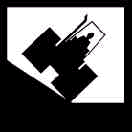 |
|
| Improper
Use, Hitching, or Maintenance of Implements Harvesting forage and hay involves mowers, rakes, balers, stackers, harrowbeds, loaders, and other machines. All have moving parts that can easily en-tangle a person who comes in contact with them. If these are used improperly, such as a platform for standing or riding, the result could be falls and runovers by the tractor or the implement. Improper hitching of the implements could cause the tractor or truck to overturn. Improper maintenance may result in loose parts flying off and striking bystanders or workers. Trying to unclog a machine when it is still running is a major reason for serious accidents. |
||
| Working
in Unfamiliar Fields Hitting a hole, rut, or stump may cause an overturn, or throw the operator from the platform of the tractor and cause an accident. |
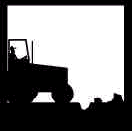 |
|
| Unsafe
Transport of Equipment Going too fast, not having clear sight when turning onto the road, failure to have the proper signs and lights, and not driving defensively all contribute to accidents. Driving on the shoulder-half on the road and half off-is dangerous since it encourages people to pass in possibly unsafe or dangerous situations. |
||
| Lifting
Bales onto a Truck or Wagon Sudden movements by the truck or tractor can throw workers off balance. Workers can fall off the platform and be run over by the machine, or they can lose control of the hay bale causing it to fall off the platform and strike a worker. |
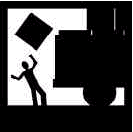 |
|
| 1. Remove stumps, stones, or other debris from the field, or clearly mark them to prevent upsets, turnovers, and damage to equipment. Also mark ditches and banks. Some banks are undercut. You need to be aware that what appears to be the edge may not be solid, but that there may be an open space below it. | 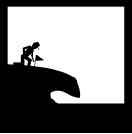 |
|
| 2. Slow down when working on hillsides. Plan harvesting so that equipment travels downhill on steep slopes to avoid overturns. Space tractor and equipment wheels as far apart as possible when operating on slopes. | ||
| 3. Keep equipment well maintained and in good repair. Keep all shields in place, especially the PTO shield. Keep platforms clear of debris. Never mount or dismount a machine when it is moving. Make sure all machines are hooked up correctly-do not hook up a 540 rpm mower to a 1,000 rpm PTO. Operating a mower or forage harvester at excessive speed can cause machine failure and possible injuries from flying debris if parts fail. | ||
| 4. Never try to unclog a machine when it is still moving
or in operation. For that matter, never attempt to work
on any machine for any reason while it is still in operation
or running. Several machines involved in harvesting forages
have cutter bars, augers, reels, crimper rolls, and other
moving parts. There are different safety precautions for
each of several different machines. Cutterbars : Stop the tractor and disengage the PTO. Raise the cutterbar and back up. Shut off the engine and engage the parking brake or shift the transmission into park (or neutral). Pull hay away from cutterbar. Check for broken guards or knife sections. Lower cutterbar. Start engine and engage PTO at low speed. Ease mower into standing hay and resume operation. Reels, Crimper Rolls, and Augers : Stop the engine and disengage the PTO before doing any work on them. Wait until the part has stopped moving. Back the material out of the equipment to unclog the unit. |
||
| 5. Although balers and bale handling systems have different parts, the same techniques apply when working on balers and bale handling systems. Disengage the PTO after shutting off the tractor. Wait for the flywheel and other moving parts to stop. Test the bale-knotter by turning the shut-off system by hand to see in slow motion what is happening with the bale-knotter. Keep hands away and observe. The same safety precautions apply to round balers. Bale ejectors are for throwing bales or rolling them into place. Never allow someone to stand behind or work on the ejector while the PTO and engine are operating. | ||
| 6. When loading bales manually, be sure that the driver does not start and stop suddenly. This can throw workers off the wagon or truck. Make sure workers do not ride on top of the stack. They could fall off and be run over. Instruct workers to be aware of the stack condition and where fellow workers are throwing the bales. Bales falling off the stack can strike a worker and result in a serious injury. | 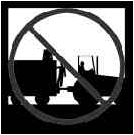 |
|
| 8. Many machines have hydraulic systems that can potentially cause serious injury if not kept in good repair and handled properly. Keep fluid clean and check often for damage to the system. Use a piece of cardboard to check for hydraulic leaks, as the high pressure can penetrate the skin. Many machines also have belts and chains. Keep these in good repair and have the right tension on them at all times. | ||
| 9. Be sure the tractor has front end ballast. This will prevent the tractor from tipping backwards. | ||
| 10. Big balers form bales weighing as much as 2,000 pounds. Do not eject bales where they might start rolling. Not much will stop a 2,000 pound bale if it starts to roll. Observe all safety precautions regarding to the PTO and the hydraulic systems. Do not let anyone stand near the rear of the baler when a bale is coming out. Again, stop the engine and disengage the PTO before dismounting to work on the baler. | ||
| General Safety Reminders | ||
| 1. Know your machine! Read the operator's manual before a machine is operated for the first time. If the machine has not been operated for a long time, first get familiar with the machine's operation. |  |
|
| 2. Wait! Be sure the harvester is completely stopped before hooking up any wagons, doing any repairs, or servicing or unclogging the header or other parts. This is especially true for the cutterhead, auger, rollers, crimpers, and PTO shafts. These parts may continue to rotate for several minutes, even after the engine stops. Do not open shields until these parts have completely stopped. Keep all doors and shields tightly latched during operation. Replace or repair all damaged shields. | ||
| 3. Stay out of danger! Never stand under or near the discharge spout of harvesters. Hard objects can become dangerous projectiles. | 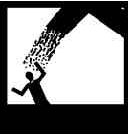 |
|
| 4. Take your time! Do not be in a hurry. Slow down and be safe. |
Written
by Tom Karsky, University of Idaho, and A. K. Jaussi, former
graduate assistant, Washington State University. For more information
about farm safety, please contact:
| Published December 1998 | Harvesting Hay and Forages |
Disclaimer and Reproduction Information: Information in NASD does not represent NIOSH policy. Information included in NASD appears by permission of the author and/or copyright holder. More